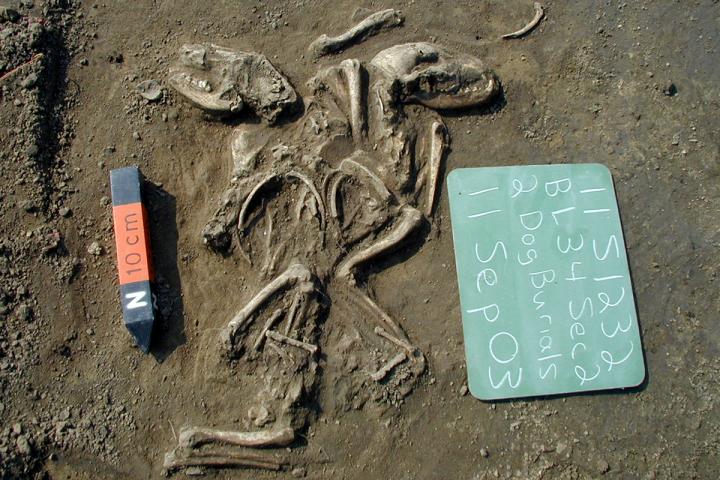Remains of Ancient American Dogs Identified at Jamestown
Dogs first came to the Americas about 16,000 years ago, likely on the heels of ice age hunters crossing a bygone land bridge from Siberia. These indigenous canines remained on the continent for thousands of years as furry friends and hunting companions—until, suddenly, they were gone, replaced genetically by European breeds.

Now, a pair of jawbones pried from the earth beneath Virginia’s colonial Jamestown settlement may illuminate when these dogs vanished and the roles they may have played in the lives of both Native Americans and European colonists.
It’s a “pretty cool” study that provides a window into a period of time in which little is known about the continent’s first dogs, says Courtney Hofman, an anthropologist at the University of Oklahoma, Norman, who was not involved with the research. “A lot of work has focused on much older indigenous dogs, but less has been done on them in more recent times.”
When Spanish conquistadors arrived in the Americas in the 15th century, they brought with them large war dogs. Later European colonists brought over working dogs such as bloodhounds and greyhounds, as well as other hunting dogs.
Gradually, these European lineages almost completely replaced the indigenous dogs of the Americas. Today, only a few arctic breeds, such as Siberian huskies and Alaskan malamutes, are thought to retain a genetic connection to their ancient past.
How and when this dramatic genetic turnover happened remains unknown. So Ariane Thomas, a graduate student studying anthropology at the University of Iowa, turned to the remains of dogs uncovered at Jamestown between 2007 and 2010.
Jamestown was the first permanent English settlement in the Americas, founded largely by explorers with little farming experience.
Thomas managed to extract mitochondrial DNA (mtDNA), inherited from the maternal line, from two canine jawbones, one found beneath a former bakery and the other inside a well thought to have belonged to Colonial Governor John Smith. Both structures date to the early 1600s.
Thomas compared the dogs’ mtDNA with that of modern and ancient dogs around the world. The Jamestown dogs’ maternal line was totally unrelated to European breeds, her team reported here last week at the annual meeting of the American Association of Biological Anthropologists. Instead, the animals were most closely related to other ancient dogs from Illinois and Ohio and were distantly related to several ancient arctic dogs, including the oldest known American dog, found in Alaska and thought to be about 10,000 years old.
Curiously, the dogs aren’t closely related to canines dated to about 1000 to 1400 C.E. found at another early Virginian colonial village known as Weyanoke, just 50 kilometres away.
“There’s a lot more diversity than maybe we initially thought,” Thomas says. That suggests European dogs may have replaced indigenous ones slowly, she says.
All the dog skull fragments recovered from Jamestown feature narrow, shallow cutmarks suggesting they were butchered, she says. The remains were also found amid food waste such as mussel shells and fish bones. The jawbone recovered from Smith’s well dates to a period known as the Starving Time, spanning the winter between 1609 and 1610 during which the Jamestown colonists nearly perished. “They were running low on supplies,” Thomas says, and “resorted to eating whatever was around.”
Some of the other dog bones were found in layers dating to at least 10 years later, suggesting eating dogs wasn’t uncommon when times got tough.
How exactly these indigenous dogs came to Jamestown remains a mystery, she says. Colonists wanted to maintain the prized lineages of European hunting dogs, so it’s unlikely they would have knowingly allowed native dogs to breed with their own, Thomas notes. Later, a law passed in 1629 expressly prohibited trading European dogs to Indigenous people.
The Jamestown dogs may also have had Indigenous owners. Thousands of mussel shell beads in various stages of construction found at the site suggest some Indigenous people—likely the local Powhatan—may have lived and worked at the settlement. If so, they may have brought their canine companions with them.
Next, Thomas hopes to sequence the nuclear DNA of the Jamestown dogs, which will reveal whether they were fully indigenous or hybrids of European-indigenous dogs.
The stories of these dogs highlight the “shared histories” of Indigenous people and colonial Europeans, says Raquel Fleskes, an anthropological geneticist at the University of Connecticut, Storrs. “It’s part of the story of Europeans learning from Indigenous societies, and [the dogs’ story] could shed light on their relationships and interactions.”
